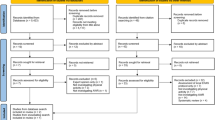Abstract
Purpose
Although ventral incisional hernia (VIH) repair in patients is often evaluated in terms of hernia recurrence rate and health-related quality of life, there is no clear consensus regarding optimal operative treatment based on these parameters. It was proposed that health-related quality of life depends largely on abdominal muscle function (AMF), and the present review thus evaluates to what extent AMF is influenced by VIH and surgical repair.
Methods
The PubMed and EMBASE databases were searched for articles following a systematic strategy for inclusion.
Results
A total of seven studies described AMF in relation to VIH. Five studies examined AMF using objective isokinetic dynamometers to determine muscle strength, and two studies examined AMF by clinical examination-based muscle tests.
Conclusion
Both equipment-related and functional muscle tests exist for use in patients with VIH, but very few studies have evaluated AMF in VIH. There are no randomized controlled studies to describe the impact of VIH repair on AMF, and no optimal surgical treatment in relation to AMF after VIH repair can be advocated for at this time.

Similar content being viewed by others
References
Cassar K, Munro A (2002) Surgical treatment of incisional hernia. Br J Surg 89:534–545
Courtney CA, Lee AC, Wilson C, O’Dwyer PJ (2003) Ventral hernia repair: a study of current practice. Hernia 7:44–46
Nieuwenhuizen J, Kleinrensink GJ, Hop WC, Jeekel J, Lange JF (2008) Indications for incisional hernia repair: an international questionnaire among hernia surgeons. Hernia 12:223–225
Giurgius M, Bendure L, Davenport DL, Roth JS (2012) The endoscopic component separation technique for hernia repair results in reduced morbidity compared to the open component separation technique. Hernia 16:47–51
Sauerland S, Walgenbach M, Habermalz B, Seiler CM, Miserez M (2011) Laparoscopic versus open surgical techniques for ventral or incisional hernia repair. Cochrane Database Syst Rev (3):CD007781. doi:10.1002/14651858.CD007781
Rosen M, Garcia-Ruiz A, Malm J, Mayes JT, Steiger E, Ponsky J (2001) Laparoscopic hernia repair enhances early return of physical work capacity. Surg Laparosc Endosc Percutan Tech 11:28–33
Helgstrand F, Rosenberg J, Kehlet H, Strandfelt P, Bisgaard T (2012) Reoperation versus clinical recurrence rate after ventral hernia repair. Ann Surg 256:955–958
Ballem N, Parikh R, Berber E, Siperstein A (2008) Laparoscopic versus open ventral hernia repairs: 5 year recurrence rates. Surg Endosc 22:1935–1940
Mussack T, Ladurner R, Vogel T, Lienemann A, Eder-Willwohl A, Hallfeldt KK (2006) Health-related quality-of-life changes after laparoscopic and open incisional hernia repair: a matched pair analysis. Surg Endosc 20:410–413
Sugerman HJ, Kellum JM Jr, Reines HD, DeMaria EJ, Newsome HH, Lowry JW (1996) Greater risk of incisional hernia with morbidly obese than steroid-dependent patients and low recurrence with prefascial polypropylene mesh. Am J Surg 171:80–84
Beltran MA, Cruces KS (2008) Incisional hernia after McBurney incision: retrospective case–control study of risk factors and surgical treatment. World J Surg 32:596–601
Si Z, Bhardwaj R, Rosch R, Mertens PR, Klosterhalfen B, Klinge U (2002) Impaired balance of type I and type III procollagen mRNA in cultured fibroblasts of patients with incisional hernia. Surgery 131:324–331
Henriksen NA, Yadete DH, Sorensen LT, Agren MS, Jorgensen LN (2011) Connective tissue alteration in abdominal wall hernia. Br J Surg 98:210–219
Moher D, Liberati A, Tetzlaff J, Altman DG, Group P (2009) Preferred reporting items for systematic reviews and meta-analyses: the PRISMA statement. J Clin Epidemiol 62:1006–1012
Gunnarsson U, Johansson M, Strigard K (2011) Assessment of abdominal muscle function using the Biodex system-4. Validity and reliability in healthy volunteers and patients with giant ventral hernia. Hernia 15:417–421
Johansson M, Gunnarsson U, Strigard K (2011) Different techniques for mesh application give the same abdominal muscle strength. Hernia 15:65–68
den Hartog D, Eker HH, Tuinebreijer WE, Kleinrensink GJ, Stam HJ, Lange JF (2010) Isokinetic strength of the trunk flexor muscles after surgical repair for incisional hernia. Hernia 14:243–247
Shestak KC, Edington HJ, Johnson RR (2000) The separation of anatomic components technique for the reconstruction of massive midline abdominal wall defects: anatomy, surgical technique, applications, and limitations revisited. Plast Reconstr Surg 105:731–738
Kuo YR, Kuo MH, Lutz BS, Huang YC, Liu YT, Wu SC, Hsieh KC, Hsien CH, Jeng SF (2004) One-stage reconstruction of large midline abdominal wall defects using a composite free anterolateral thigh flap with vascularized fascia lata. Ann Surg 239:352–358
Parker M, Goldberg RF, Dinkins MM, Asbun HJ, Daniel Smith C, Preissler S, Bowers SP (2011) Pilot study on objective measurement of abdominal wall strength in patients with ventral incisional hernia. Surg Endosc 25:3503–3508
Kuzbari R, Worseg AP, Tairych G, Deutinger M, Kuderna C, Metz V, Zauner-Dungl A, Holle J (1998) Sliding door technique for the repair of midline incisional hernias. Plast Reconstr Surg 101:1235–1242
Stark B, Emanuelsson P, Gunnarsson U, Strigard K (2012) Validation of Biodex system 4 for measuring the strength of muscles in patients with rectus diastasis. J Plast Surg Hand Surg 46:102–105
Schoenmaeckers EJ, Wassenaar EB, Raymakers JT, Rakic S (2010) Bulging of the mesh after laparoscopic repair of ventral and incisional hernias. JSLS 14:541–546
Dulin WA, Avila RA, Verheyden CN, Grossman L (2004) Evaluation of abdominal wall strength after TRAM flap surgery. Plast Reconstr Surg 113:1662–1665
Paiuk I, Wasserman I, Dvir Z (2012) Effects of abdominal surgery through a midline incision on postoperative trunk flexion strength in patients with colorectal cancer. Hernia. doi:10.1007/s10029-012-1027-x
Balogh B, Zauner-Dung A, Nicolakis P, Armbruster C, Kriwanek S, Piza-Katzer H (2002) Functional impairment of the abdominal wall following laparoscopic and open cholecystectomy. Surg Endosc 16:481–486
Conflict of interest
The authors declare that they have no conflict of interest.
Author information
Authors and Affiliations
Corresponding author
Rights and permissions
About this article
Cite this article
Jensen, K.K., Kjaer, M. & Jorgensen, L.N. Abdominal muscle function and incisional hernia: a systematic review. Hernia 18, 481–486 (2014). https://doi.org/10.1007/s10029-014-1242-8
Received:
Accepted:
Published:
Issue Date:
DOI: https://doi.org/10.1007/s10029-014-1242-8




